Owning An OES
About The Breed
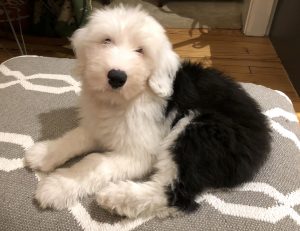 The Old English Sheepdog is not as old as it might sound, but it can be traced as a distinct breed back over 200 years. There are conflicting ideas as to its origin, but it is believed to have been developed in the west of England in the counties of Devon and Somerset, and the Duchy of Cornwall. There were dogs known as "drover's dogs" used to drive sheep and cattle to market. To prove their occupation as working dogs, their tails were docked; thus, their owners were exempt from taxes placed on dogs kept as pets.
The Old English Sheepdog is not as old as it might sound, but it can be traced as a distinct breed back over 200 years. There are conflicting ideas as to its origin, but it is believed to have been developed in the west of England in the counties of Devon and Somerset, and the Duchy of Cornwall. There were dogs known as "drover's dogs" used to drive sheep and cattle to market. To prove their occupation as working dogs, their tails were docked; thus, their owners were exempt from taxes placed on dogs kept as pets.
The Bobtail was first found in the show ring in 1873 at Birmingham, England, while the first Old English Sheepdog Club was founded, and a scale of points for the breed laid down, in 1888. The Old English generally has a happy, rough and tumble disposition; he is always ready for action. He makes an ideal house pet not usually given to roaming. If your preference is for an outdoor dog to be left pretty much to fend for itself, this is not the breed for you. The OES is a hardy, intelligent herding dog, which prefers to spend his time with his family.
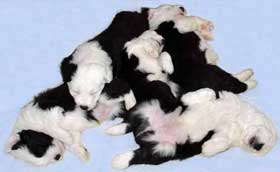 The massive coat of the breed may serve as a deterrent to some who feel they may not be able to undertake the responsibility for its care; however, once a week thorough grooming will keep the dog relatively mat-free. The combings can be collected and spun into an excellent yarn suitable for either knitting or hand weaving. Without regular grooming, the dog can quickly become dirty, matted, and unpleasant to have around. The coat of an unkempt dog is a trap for dust, debris, fecal matter, urine and moisture - an unhealthy condition for both you and the dog.
The massive coat of the breed may serve as a deterrent to some who feel they may not be able to undertake the responsibility for its care; however, once a week thorough grooming will keep the dog relatively mat-free. The combings can be collected and spun into an excellent yarn suitable for either knitting or hand weaving. Without regular grooming, the dog can quickly become dirty, matted, and unpleasant to have around. The coat of an unkempt dog is a trap for dust, debris, fecal matter, urine and moisture - an unhealthy condition for both you and the dog.
How To Purchase An Old English Sheepdog
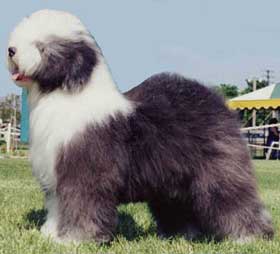 The best place to purchase any breed of dog is from a reputable breeder. The reputable breeder is interested solely in producing sound, healthy Old English Sheepdogs with as much adherence to the AKC Standard for the breed as possible. He devotes much time and energy (and money) selecting the dogs to be used in his breeding program. He has signed a copy of the OESCA Code of Ethics and it is on file. He is concerned about health issues in the breed, and screens his buyers for their suitability for owning an OES. Pets and show dogs come from the same litter, but each require the same care and attention. By purchasing your puppy from a breeder who is consistently placing his dogs under the scrutiny of the judges in the show ring, your chances for acquiring a good disposition, well-bred family pet are enhanced. There is no excuse for buying a puppy from someone who is exploiting the breed.
The best place to purchase any breed of dog is from a reputable breeder. The reputable breeder is interested solely in producing sound, healthy Old English Sheepdogs with as much adherence to the AKC Standard for the breed as possible. He devotes much time and energy (and money) selecting the dogs to be used in his breeding program. He has signed a copy of the OESCA Code of Ethics and it is on file. He is concerned about health issues in the breed, and screens his buyers for their suitability for owning an OES. Pets and show dogs come from the same litter, but each require the same care and attention. By purchasing your puppy from a breeder who is consistently placing his dogs under the scrutiny of the judges in the show ring, your chances for acquiring a good disposition, well-bred family pet are enhanced. There is no excuse for buying a puppy from someone who is exploiting the breed.
Those people who have bred a litter "just for fun" are generally not in a position to advise you correctly regarding their puppies. They simply are not knowledgeable enough to know what they have and will tell you everything is wonderful so as to not risk discouraging a sale. Someone who has never shown a dog is not in a position to define what constitutes a show quality puppy, and yet many do. In addition, someone who has bred their pet most likely did not acquire that pet from a reputable breeder because good breeders insist that their pet quality dogs be neutered.
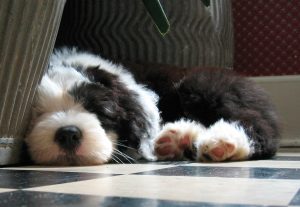 Puppy Mills and Pet Shops are in the business of making a profit and buy their stock at wholesale prices. The AKC is currently investigating anyone who registers more than 7 or 8 litters a year to check the integrity of their record keeping. A load of puppies shipped to a pet store cannot really testify as to who mommy or daddy really are so mix-ups in pedigrees and registration papers are common. By representing so many different breeds pet shops are in no position to specialize in any one breed. They are interested in selling and will give you a very positive pitch. In addition, they don't care who buys the puppy--just so someone buys it. And, just because a puppy has a pedigree and AKC registration papers is no guarantee of his health or quality.
Puppy Mills and Pet Shops are in the business of making a profit and buy their stock at wholesale prices. The AKC is currently investigating anyone who registers more than 7 or 8 litters a year to check the integrity of their record keeping. A load of puppies shipped to a pet store cannot really testify as to who mommy or daddy really are so mix-ups in pedigrees and registration papers are common. By representing so many different breeds pet shops are in no position to specialize in any one breed. They are interested in selling and will give you a very positive pitch. In addition, they don't care who buys the puppy--just so someone buys it. And, just because a puppy has a pedigree and AKC registration papers is no guarantee of his health or quality.
When you buy from a dedicated breeder, you also receive his help, interest, suggestions and breed knowledge. All breeding stock should be proven free of eye defects, hip dysplasia, and deafness. Breeders of Old English Sheepdogs who are members of the Old English Sheepdog Club of America must support its Code of Ethics in breeding and selling sheepdogs. All breeding stock should be proven free of hip dysplasia and eye defects. Pups should be free of internal parasites, have current vaccinations from common dog diseases, be at least eight weeks of age, and should come with written instructions regarding feeding, health, training and grooming. The dog should be guaranteed against hereditary faults and should be replaced if it is found to have a life- threatening defect, or your purchase price refunded. Reputable breeders will interrogate prospective buyers regarding their plans for housing and training. They will insist on the dog being neutered, and if the buyer can no longer keep the dog, or they are not satisfied with owning an Old English Sheepdog, they will request that the dog be returned to them. It is possible that they will withhold AKC registration papers until proof is supplied that the dog has been neutered, or will sell the dog on a limited registration. Written legal contracts between buyer and seller are common and recommended. When you purchase an OES from a reputable breeder you are not only receiving a dog, but a lifetime of help and advice.
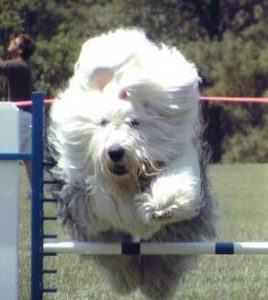 It is wise for the buyer to become knowledgeable about those hereditary defects common to this breed. The buyer should question the breeder and make judgments as to the breeder's feeling of responsibility regarding any testing which has been done on his breeding stock. Most canine registries provide written evidence of any testing done and the results, and it is within the buyer's rights to request copies of that material. In other words, don't settle for "the Vet says our dogs are fine--we've never had any problem with that."! For instance, as a future owner of an OES or any other large breed of dog, you should know about Canine Hip Dysplasia. This disease is seldom crippling, but can be diagnosed by pelvic radiograph taken at two years of age, and the dog should not be bred if this xray does not receive Orthopedic Foundation for Animals or Veterinary Radiologist Certification. Request certification ID #'s. Plus, even though both parents are certified clear of HD, no one can assure you your dog will not develop HD.
It is wise for the buyer to become knowledgeable about those hereditary defects common to this breed. The buyer should question the breeder and make judgments as to the breeder's feeling of responsibility regarding any testing which has been done on his breeding stock. Most canine registries provide written evidence of any testing done and the results, and it is within the buyer's rights to request copies of that material. In other words, don't settle for "the Vet says our dogs are fine--we've never had any problem with that."! For instance, as a future owner of an OES or any other large breed of dog, you should know about Canine Hip Dysplasia. This disease is seldom crippling, but can be diagnosed by pelvic radiograph taken at two years of age, and the dog should not be bred if this xray does not receive Orthopedic Foundation for Animals or Veterinary Radiologist Certification. Request certification ID #'s. Plus, even though both parents are certified clear of HD, no one can assure you your dog will not develop HD.
DISCLAIMER:
 Our breed referral person can help you, but the responsibility for researching, learning about the breed, becoming familiar with the OESCA Code of Ethics, and ultimately a successful relationship with your Old English Sheepdog rests with you--and we want that relationship to be very successful. The Old English Sheepdog Club of America and its members make every effort to represent quality breeders of Old English Sheepdogs. As signers of the OESCA Code of Ethics the services breeders have to offer hopefully adhere to this Code. However, the OESCA in no way endorses any one particular breeder or his/her puppies; and specifically disclaims responsibility for any misrepresentations, and maintains no involvement in agreements between buyer and seller.
Our breed referral person can help you, but the responsibility for researching, learning about the breed, becoming familiar with the OESCA Code of Ethics, and ultimately a successful relationship with your Old English Sheepdog rests with you--and we want that relationship to be very successful. The Old English Sheepdog Club of America and its members make every effort to represent quality breeders of Old English Sheepdogs. As signers of the OESCA Code of Ethics the services breeders have to offer hopefully adhere to this Code. However, the OESCA in no way endorses any one particular breeder or his/her puppies; and specifically disclaims responsibility for any misrepresentations, and maintains no involvement in agreements between buyer and seller.
Old English Sheepdogs used for breeding should have their eyes cleared of hereditary defects by a Certified Veterinary Ophthalmologist, and their hearing should be Baer tested (http://www.offa.org/deaf_baer.html) by an expert in this procedure. The owner of the litter will have certificates of clearance and should provide you with copies of those in addition to copies of the parents' American Kennel Club Registrations to enable you to cross reference. Please read more about health issues in the Breed on the OESCA Health and Research website which is constantly being updated as information becomes available. Click "Health" on the OESCA main menu.




